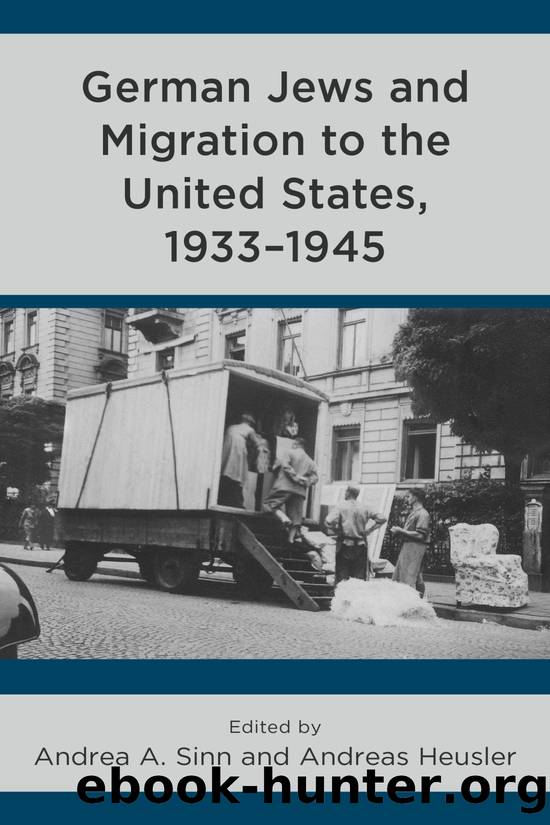German Jews and Migration to the United States, 1933â1945 by Andrea A. Sinn

Author:Andrea A. Sinn
Language: eng
Format: epub
ISBN: 9781793646019
Publisher: Lexington Books
Published: 2022-02-07T00:00:00+00:00
Part II
ExileâEmigration and New Beginnings Abroad
It was one of the largest and most dramatic mass migrations of the 20th century. Between 1933 and 1939, some 247,000 German Jews, almost half of the 1933 German Jewish population, left the country that had been their home. Far fewer, around 25,500, fled Nazi Germany between September 1939âthe outbreak of World War IIâand October 1941, when emigration was prohibited. The vast majority of those who emigrated were educated, wealthy middle- and upper-class citizens who would not have considered moving to a country with a language they did not speak and customs they did not understand before Hitlerâs appointment as Reich chancellor on January 30, 1933. While most of the Jewish emigrants from Nazi Germany initially fled to other European countries and Palestine, about 81,500 who self-identified as Jews by religion eventually made it to the United States, despite the strict immigration restrictions enacted by the US Congress after World War I. In contrast to earlier waves of immigration, this group of incoming refugees included a larger proportion of women, children, and adults aged 45 and older. The experiences of those trying to establish themselves in the United States differed, depending on whether the new immigrants were part of the German cultural elite (a minority) or came as refugees. The latter in particular were faced with many economic and cultural challenges while trying to find their place. Geographically, these Jewish immigrants settled primarily on the East Coast, especially in New York City. Los Angeles became a main center on the West Coast, but there were also many smaller settlements in other large and small communities throughout the United States.
The personal testimonies gathered in the second part of this book are allâexcept for two memoirs originating from the Leo Baeck Institute New Yorkâpart of the Judaica collection in the Munich City Archives. They represent an enormous diversity of fates and circumstances that shaped and defined the thousands of individual experiences of emigration and exile in the United States. They also feature many key issues that emigrants faced in different parts of the world and raise questions about the importance and dynamics of transmigration, migrant networks, and the complex relationships between national policies and migrant agencies. Compared to the rest of the German Reich, a particularly high number of emigrants fled from Munich to the United States. One possible explanation for this could be relatively higher rates of emigration from Bavaria to the United States in the 19th and the early 20th centuries. Immigrants who had family contacts in the country may have benefited in obtaining affidavits, which was crucial for entry to the United States.
The emigration process, including detours and experiences in other places, are the foci of the memoirs written by Charlotte Haas Schueller and Hanns Peter Merzbacher. These two young adults were just beginning their professional careers when they left Germany. After temporary stays in England and Brazil, respectively, they arrived in the United States shortly before the end of the war. Ilse E.
Download
This site does not store any files on its server. We only index and link to content provided by other sites. Please contact the content providers to delete copyright contents if any and email us, we'll remove relevant links or contents immediately.
| African | Asian |
| Australia & Oceania | Canadian |
| Caribbean & Latin American | European |
| Jewish | Middle Eastern |
| Russian |
The Hating Game by Sally Thorne(19117)
The Universe of Us by Lang Leav(15008)
Sad Girls by Lang Leav(14312)
The Lover by Duras Marguerite(7831)
The Rosie Project by Graeme Simsion(6194)
Smoke & Mirrors by Michael Faudet(6132)
Big Little Lies by Liane Moriarty(5703)
The Shadow Of The Wind by Carlos Ruiz Zafón(5642)
The Poppy War by R. F. Kuang(5578)
An Echo of Things to Come by James Islington(4756)
Memories by Lang Leav(4751)
What Alice Forgot by Liane Moriarty(4568)
From Sand and Ash by Amy Harmon(4387)
The Poetry of Pablo Neruda by Pablo Neruda(4041)
The Tattooist of Auschwitz by Heather Morris(3794)
Ficciones by Jorge Luis Borges(3574)
Guild Hunters Novels 1-4 by Nalini Singh(3409)
The Rosie Effect by Graeme Simsion(3375)
THE ONE YOU CANNOT HAVE by Shenoy Preeti(3292)
